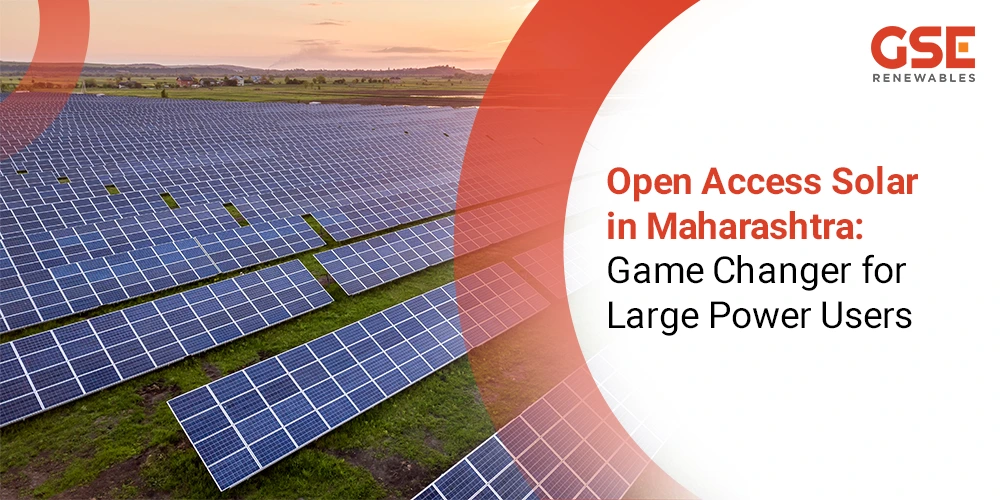500 kW Solar Power Plant Cost in Gujarat: Complete Price & Savings Guide
Nov 26

Maharashtra has become a leading hub for renewable energy, with rapid adoption of open access solar solutions across industries. As both private enterprises and public sectors explore greener energy alternatives, open access solar in Maharashtra has emerged as a practical and scalable option. It allows large power consumers to directly source solar electricity from off-site producers offering savings, sustainability and operational reliability.
This system is helping accelerate solar energy in Maharashtra by reducing dependency on local DISCOMs and empowering industries with cleaner, cheaper power alternatives.
Open access solar power allows eligible consumers, especially large Commercial and Industrial (C&I) establishments to buy power directly from solar energy plants in Maharashtra, bypassing local distribution networks. Established under the Electricity Act, 2003, the open access solar policy promotes competition and consumer choice.
Unlike rooftop systems, open access solar power plants are typically utility-scale facilities located off-site. Companies with limited space can still benefit from renewable energy by connecting to these distant plants via the grid. This model also contributes significantly to solar power generation in Maharashtra, enabling factories, data centers, and industrial estates to decarbonize rapidly.
The open access solar policy Maharashtra operates under the Green Energy Open Access (GEOA) Rules, 2022, introduced by Maharashtra Electricity Regulatory Commission (MERC). This regulation supports direct procurement of renewable power, with key provisions including:
Let’s understand the process of Open Access Solar plant installation—where clean energy is captured at off-site solar farms, converted, and delivered via the grid to your facility, enabling cost savings and sustainable operations without disruption. This model supports both open access solar power plant deployments and open access solar projects across Maharashtra.
Industrial users in Maharashtra typically face high grid tariffs, which significantly impact operational expenses. Open Access Solar offers a compelling alternative by providing cleaner electricity at competitive rates—while also offering long-term financial benefits.
Though Open Access Solar includes additional charges like wheeling, transmission, and banking, the overall cost per unit remains favorable compared to traditional grid power. Over time, businesses switching to solar through open access arrangements can realize substantial monthly and annual savings on electricity bills.
The return on investment (ROI) for Open Access Solar projects is also attractive. Most industrial users begin seeing positive cash flow within a few years, with a clear payback period that aligns well with financial planning cycles. When paired with incentives, renewable purchase obligations (RPO) compliance, and green energy branding, the shift becomes not only cost-effective but also strategically advantageous.
By leveraging expert planning, energy audits, and customized solar solutions from GSE Renewable Energy, factories and commercial users can optimize savings while ensuring uninterrupted energy access.
Let’s explore how open access solar offer benefits to industries such as cut energy costs, lock in stable tariffs, meet sustainability goals & gain a competitive edge through reliable, clean power.
GSE Renewable Energy provides end-to-end support for industrial open access solar projects:
With GSE’s comprehensive services from regulatory clearances to ongoing performance monitoring industrial clients can confidently transition to efficient and scalable open access solar solutions.
With favorable policies, robust infrastructure, and rising industrial demand, Open Access Solar in Maharashtra is revolutionizing the way power is procured and consumed. It’s not just a cost-saving opportunity it’s a strategic move toward sustainable growth. If you’re an industrial consumer looking to reduce costs and emissions, open access solar power in Maharashtra offers the most scalable solution available today.
Partner with GSE Renewable Energy and take charge of your energy future one solar energy plant in Maharashtra at a time.
It allows large consumers to purchase power from an off-site solar energy plant in Maharashtra, using the grid for delivery while reducing dependency on DISCOMs.
Yes. Typical savings range from 25–40%. While grid power costs ₹9–12/unit, open access solar delivers electricity at ₹5.50–₹7.00/unit.
Yes. Industrial consumers with 1 MW load or more can invest in a 1 MW solar power plant in Maharashtra under a captive model with 26% equity.
To successfully implement Open Access Solar, businesses must meet specific regulatory, technical & contractual requirements that ensure smooth energy transmission and compliance with state electricity boards.
If the power is sourced from existing solar farms, the implementation timeline typically ranges from 60 to 90 days. However, if you’re setting up a new captive solar power plant, the process may take approximately 6 to 9 months, depending on land acquisition, regulatory approvals, and infrastructure development.
Our Blogs With a combined experience of over 250 years and the successful management of 30 MW of solar energy projects, GSER offers the most efficient solutions. 500 kW Solar Power Plant Cost in Gujarat: Complete Price & Savings Guide What is a 500 kW...
Read MoreOur Blogs With a combined experience of over 250 years and the successful management of 30 MW of solar energy projects, GSER offers the most efficient solutions. Why Solar Power Is Booming in Gujarat for Businesses Over the last decade, Gujarat has become one of...
Read MoreOur Blogs With a combined experience of over 250 years and the successful management of 30 MW of solar energy projects, GSER offers the most efficient solutions. Solar Opex Model: For Rooftop Solar with No Upfront Investment What is the OPEX Model in Solar Energy?...
Read More